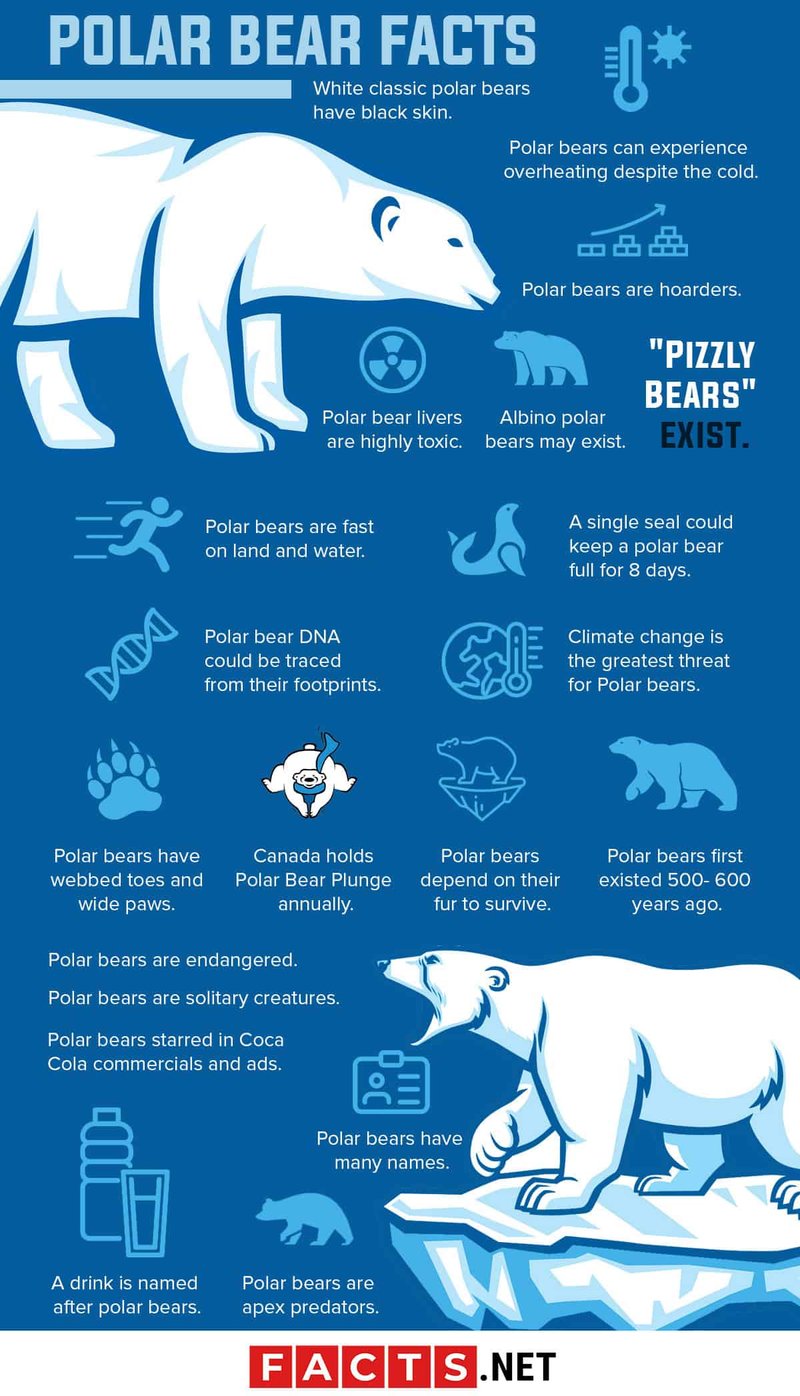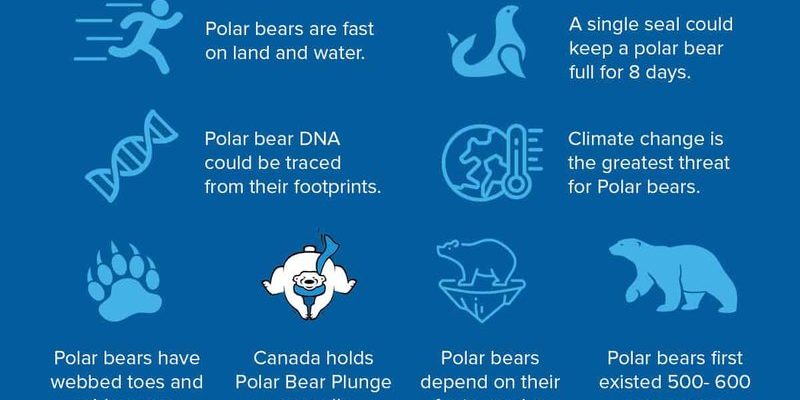
Let’s dive into some fascinating facts about the polar bear. It’s like peeling back the layers of an onion—each layer revealing something new and intriguing about how these magnificent animals live, survive, and thrive in one of the harshest climates on Earth. So grab your warm drink, sit back, and let’s explore the captivating world of polar bears.
1. Polar Bears Are Not Pure White
You might picture polar bears as fluffy, white snowballs, but here’s the twist—polar bears are actually transparent! Their fur consists of hollow, clear hairs that reflect light, which makes them appear white against the snow. This clever adaptation helps them blend into their icy surroundings, allowing them to sneak up on their prey. It’s almost like nature’s own “invisibility cloak.”
Interestingly, their skin is black! This characteristic helps absorb sunlight, keeping them warm in the frigid Arctic temperatures. So, next time you see a polar bear, remember it’s not just the white fur that keeps them hidden; it’s a whole host of clever adaptations working together.
2. They’re the Largest Carnivorous Land Mammals
Polar bears are the kings of the Arctic when it comes to size. Adult males can weigh anywhere from 900 to 1,600 pounds! To put that into perspective, that’s about the weight of a small car. Their massive size is not just for show; it plays a crucial role in their survival. The extra weight helps them store fat, which is essential for insulation against the cold and for energy during times when food is scarce.
Females are smaller, usually weighing between 330 to 650 pounds, but they are still formidable hunters. These bears can reach lengths of up to 10 feet when standing on their hind legs, making them a truly impressive sight to behold. Imagine encountering a creature that large while venturing through the snowy wilderness!
3. Their Diet is Primarily Seals
You might be surprised to learn that polar bears primarily feast on seals, particularly ringed and bearded seals. They rely on their incredible sense of smell to detect seals hidden beneath the ice. Polar bears can sniff out a seal from nearly a mile away! It’s like having a superpower in the Arctic.
To catch their dinner, they often use a technique called “still-hunting.” This involves waiting patiently by a seal’s breathing hole, often for hours, until the unsuspecting seal surfaces for air. Their stealth and patience are remarkable, showcasing the harsh reality of life in their icy domain.
4. They’re Expert Swimmers
Did you know polar bears are fantastic swimmers? They can paddle through icy waters for several miles without becoming exhausted. Their large front paws act like powerful paddles, propelling them through the frigid ocean with ease. Some polar bears have been recorded swimming over 30 miles in search of food or ice.
Their swimming abilities are more than just a fun fact; they play a critical role in their survival as climate change rapidly melts sea ice. As these bears need to travel longer distances to find stable ice, being strong swimmers helps them adapt to their changing environment.
5. Polar Bears Have a Unique Heating System
Living in the Arctic means dealing with extreme cold, and polar bears have a built-in heating system to survive. They have several inches of blubber under their skin that acts as insulation, keeping them warm even in sub-zero temperatures. On top of that, their thick fur traps air, which adds another layer of warmth.
When they get too hot while running or during the warmer months, these bears can even cool off by taking a dip in icy waters. It’s like having your own personal air conditioner while living in one of the coldest places on Earth!
6. They Have Complex Social Behaviors
You might think of polar bears as solitary creatures, but they have a surprisingly complex social structure. While adult males are mostly solitary, females and their cubs are often seen together, forming strong bonds. Mothers are deeply caring and protective, teaching their young how to hunt and survive in the harsh Arctic environment.
Interestingly, polar bears have been observed playing with each other, especially in the summer when food is more plentiful. Their playful behavior can involve wrestling or chasing each other on the ice, showcasing a lighter side to their otherwise serious existence as apex predators.
7. They Can Overheat!
One surprising fact about polar bears is that they can actually overheat. With all that blubber and fur, you might wonder how they manage in warmer weather. Surprisingly, they have a hard time cooling down after exertion. It’s a tricky balance—while they need the insulation to survive harsh winters, it can be a hindrance when it’s warmer.
To cool off, polar bears will take frequent breaks, swim in cold water, or even roll around in the snow. Maintaining their body temperature is critical for their health and survival. Think about how you adjust your clothing or seek shade on a hot day; polar bears do something similar!
8. Climate Change Threatens Their Habitat
One of the most pressing issues polar bears face today is climate change. As the planet warms, sea ice is melting at alarming rates, affecting their ability to hunt seals. This loss of habitat means that polar bears are forced to travel farther to find food, which can lead to starvation and declining populations.
You might be wondering why this matters. Polar bears are not just iconic symbols of the Arctic; they play a vital role in maintaining the balance of their ecosystem. Their decline can have a ripple effect on other species and the overall health of the Arctic environment.
9. Their Cub Survival Rate is Low
Polar bear cubs are undeniably adorable, but they face significant challenges in their early life. Typically, a mother gives birth to two cubs, though sometimes it can be just one or even three. Unfortunately, the survival rate of these cubs is low, largely due to harsh environmental conditions and limited food sources.
Cubs stay with their mothers for about two and a half years, where they learn vital survival skills. During this time, they grow rapidly and develop the necessary skills to hunt and navigate their icy habitat as they prepare for independence.
10. Polar Bears are a Vulnerable Species
The IUCN (International Union for Conservation of Nature) classifies polar bears as a vulnerable species. Their populations are declining due to habitat loss, climate change, and diminishing food sources. Conservation efforts are crucial to ensure that these magnificent creatures can thrive in a changing world.
Organizations around the globe are working to protect polar bear habitats and raise awareness about their plight. Every small action counts. By supporting conservation efforts, you can contribute to preserving these amazing animals for future generations.
In conclusion, polar bears are remarkable creatures with unique adaptations that allow them to thrive in one of the harshest environments on Earth. From their transparent fur to their expert swimming ability, these magnificent animals are more than just snowy icons. They play a vital role in their ecosystem, and understanding their lives helps us appreciate the delicate balance of nature. As we face the realities of climate change, it’s essential to advocate for their survival and the preservation of their habitat.

